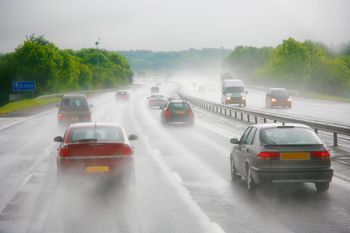
Moderate to heavy rainfall may impact vehicle safety systems and cause vehicle performance problems.
Vehicle Safety Systems and Rainy Weather
Most drivers are aware of driving hazards in the rain such as slick tires, stopping difficulty, skidding, and hydroplaning. However, many drivers don’t know that driving in the rain can blind their vehicle safety systems that rely on sensors and cameras to detect impending dangers.
According to AAA safety studies, rain can affect a vehicle safety system’s ability to see the road. During vehicle tests that simulated moderate to heavy rainfall, automatic braking systems, lane assist systems, and advanced-driver systems failed numerous safety tests.
Automatic Braking Systems
Automatic emergency braking (AEB) is a system that automatically activates a vehicle’s brakes when a potential collision is detected. By using sensors such as radar, infrared scanners, and cameras, these braking systems scan for other vehicles, objects, and pedestrians in front of the moving vehicle. AEB systems proactively apply the brakes when a possible collision is detected without the driver touching the brake pedal.
Lane Assist Systems
A lane assist system proactively supports a driver by keeping the vehicle centered in the lane of travel. This system relies on a camera sensor mounted behind the windshield in front of the rearview mirror. If a vehicle is moving faster than 37 mph, the lane assist camera detects lane markers on the road ahead. In drunk driving accidents, car accident lawyers often see drivers saved by this technology.
Advanced Driver-Assistance Systems
Advanced driver-assistance systems (ADAS) come with special features including:
- Forward-collision warnings
- Lane departure warnings
- Night vision blind spot technology
- Pedestrian detection
- Traffic sign recognition
- Parking sensors
ADAS systems rely on sensors that receive a continuous stream of information about the environment surrounding the vehicle.
AAA tests results showed a variety of potentially life-threatening problems while driving in rain. Because rain often blinded sensors and cameras used to detect collisions, test vehicles traveling at 35 mph or greater collided with stopped vehicles at least 33% of the time. Automatic emergency braking systems simply failed to interact, so drivers were forced to quickly apply the brakes. Lane assist and advanced driver-assistance systems failed to detect road markers, traffic signs, and pedestrians about 70% of the time.
For optimum traffic safety, AAA urges drivers with vehicle safety systems to understand how their systems work by reading their owner’s manual and realizing that rain can impact safety sensors.

